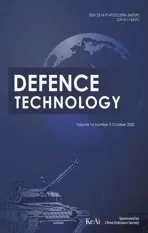Crashworthiness performance of hybrid kenaf/glass fiber reinforced epoxy tube on winding orientation effect under quasi-static compression load
2020-10-27SupinSpunZuhriZinudin
A.B.M. Supin , S.M. Spun ,b,*, M.Y.M. Zuhri , E.S. Zinudin , H.H. Y
a Advanced Engineering Materials and Composites Research Centre,Department of Mechanical and Manufacturing Engineering,Universiti Putra Malaysia,4 3400, UPM Serdang, Selangor, Malaysia
bLaboratory of Biocomposite Technology, Institute of Tropical Forestry and Forest Products (INTROP) Universiti Putra Malaysia, 43400, UPM Serdang,S elangor, Malaysia
cDepartment of Mechanical Engineering, Universiti Teknologi Petronas, 32610, Seri Iskandar, Perak, Malaysia
ABSTRACT This research was aimed to study the effect winding orientation on the crashworthiness performance of hybrid tube. The specimens tested under quasi-static compression load involve of three winding parameters (θ = 30°, 45° and 70°) of hybrid kenaf/glass fiber reinforced epoxy and glass fiber reinforced epoxy as contrast specimen. The automated filament winding technique has been used in fabrication of hybrid and non-hybrid composite tube and crashworthiness performance was investigated experimentally. The effects of winding orientation on energy absorption capabilities and crashworthiness characteristic were investigated through quasi-static compression load and the result are compared with the glass fiber composite tube to justify the capability of hybrid natural/synthetic as energy absorption application.Hybridized samples proved to enhancing the progressive crushing capability as combination of local buckling, delaminate and brittle fracturing as progressive crushing modes.
1. Introduction
The hybrid composite material has been progressively recognized in various advanced material industries and researchers as a prospective engineering material. The study of hybrid composite energy absorption tube bring out abundantly of a new finding and have a numerous synergistic enhancement property in the field of nature composite study where it has advantage on being at economical to manufacture, eco-friendly, harmless to health,lightweight, high stiffness and specific strength provide a possible alternative to the synthetic fiber[1].Therefore,a various technique of fabricating the hybrid composite structures are existing in various scale [1-4]. The principle and method of fabricating the energy absorption tubes from distinct composite materials could be affected by various results of structure deformation and crashworthiness performance [6-11]. Therefore, the combination of several different types of fibers into a single matrix has led to more advantageous stability between the inherent advantages and disadvantages, which the advantages of one type of fiber could complement with what is lacking in the other [4,8-12].
Krishnan et al. [13] have a study the effects of winding orientation on the behaviour of glass/epoxy composite tubes under multiaxial cyclic loading and the results has indicated that each winding orientation dominates a distinctive optimum pressure loading condition. Morozov [14] have studied the modelling and stress analysis of filament-wound composite shells with the effects in filament winding orientation which have significantly affected the distinctive geometric pattern and the stress and strain fields in the thin-walled composite shells. Meanwhile, the study by Rousseau et al. [15] of the interweaving of fibers in the helical winding method has characterised the influence the mechanical performance and damage behaviour under various loading.Besides,from a test carried out by Rousseau, the physical of specimen showed a presence of undulation form in interwoven structures. As a different, Kurt and Srinivasan [16] has explained in their study of the undulation structure with weaving effects in a filament-wound tube are not persistent and a distinct structure will have various shapes and sizes of undulation. Meanwhile the study by E. Mahdi et al. [17] has detailed that the benefits of filament winding technique which explained of one superior type of fiber can be used to counterpart the poor performance of other type,whereas,E.Mahdi has focused on hybridization carbon fiber reinforced polymer composite with glass fiber reinforced polymer composite and the result has showed that static crushing behavior of filament wound hybrid Carbon/Glass fiber reinforced polymer tube has influenced by the reinforcement sequence parameter, moreover the layer of Glass/Carbon/Glass exhibited good energy absorption capability in various parameter of hybrid Carbon/Glass fiber reinforced polymer composite tube laminate.
From the above review,this present study has showed the stateof-the-art in developing the hybrid natural/synthetic fiber composite tube which it considered a novel improvement of hybrid composite tube study in filament winding technique to fabricate and synergize of two or more composite fiber into one single fiber band to become hybrid energy absorption tube. It will be a new investigation to discover the potential applications of hybrid natural/synthetic fiber-reinforced composites tube in various mechanical properties and crashworthiness performance through filament winding technique. Therefore, the effect of winding orientation in the filament winding technique has been marked and linked with previous study to investigate the collapse behavior of hybrid kenaf/glass fiber reinforced epoxy composite tube which effected in the micro-mechanisms of composite fiber/matrix.Moreover,the hybrid kenaf/glass reinforced epoxy composite tube has compared to the synthetic glass fiber reinforced epoxy composite tube to distinguish the crashworthiness performance and failure mode behavior response in quasi-static compression load.
2. Materials and method
2.1. Raw material
The kenaf fiber yarn (Kenaf 2000) supplied by Innovative Pultrusion Sdn.Bhd.without any surface treatment and glass fiber(EGlass) by Owens Corning Advantex®. The hybrid composite tube will consists of two different fibers which has been set and aligned in single wet fiber band,where the glass fiber diameter was 13-μm and for kenaf fiber diameter was 1±0.5 mm.Meanwhile the Epoxy Resin D.E.R.™324 is supplied by Sirim-Tech Venture Sdn. Bhd.
2.2. Sample preparation
The preparation of the three hybrid and three non-hybrid tubes in this study is customized with continues fibers tow from kenaf fiber yarn, glass fiber, and epoxy resin (Fig.1). The various consideration of hybrid fiber band in a filament winding process is synchronized by factors of the velocity of the filament winding, fiber tension, and the winding orientation [18-23]. Thus, the hybrid fiber band was gathering and roll into resin bath by an automated feeder in wet filament by aluminum mandrel (Fig. 1(a)). Three groups of hybrid kenaf/glass fiber composite specimen with a total of six plies were manufactured by varying the winding orientation,meanwhile three group of glass fiber composite tube (GFRP)specimen were manufactured with nine plies which to equaled with hybrid tube wall thickness,the operation could be repeated to form additional layers until the desired part thickness has been gained (Fig.1(b)),[3].
Initially, at the process of filament winding the hybrid composite tubes produced with 1000 mm in length and 50 mm internal diameter. Then, the tube specimen cut into the required length by using a saw-blade machine and the edge cutting has been refined to prevent any crack before experiment. All specimen of hybrid and non-hybrid tubes for wall thickness and length measured with the range of 7.13-7.89 mm and 99.15-101.88 mm respectively. The winding orientation angle θ = 30°, 45°and 70°was select to justified for three-zone (low, medium and high) of filament winding will provide the best characteristic in-term of mechanical properties and crashworthiness performance. Therefore, three parameters selected will reveal various winding patterns to determine failure mode behavior and progressive crushing characteristic. Finally, the specimens cured at room temperature(32°C)for 24 h to give the best tube structure hardness and rigidity.
2.3. Quasi-static - axial crushing test
Usually, the quasi-static experiment or testing in the study of composite material has performed to conduct both fundamental and verification tests for structural performance of structures such as the rate of mode of collapse, propagation of cracks and related stages of destruction [24-32]. Axial quasi-static axial crushing testing was performed by Instron Universal Test Machine (UTM -MTS 3382)with constant rate of 5 mm/min and a loading capacity of 100 kN.The tested specimens performed which has followed to the standard code ASTM: D7336M-12. All specimens are set for±10 mm in height and will crush at 80%-100% tube crushing displacement.
The test specimens were compressed with the constant quasistatic condition through standard, therefore the load and displacements were recorded by an automatic data acquisition system and with standard flat crossheads of the press. Based on a loaddisplacement curve, the data were then calculated the crashworthiness characteristics as follow; the peak load, mean load and Specific Energy Absorption (SEA) of the hybrid composite tube specimen and non-hybrid composite tube (kenaf fiber reinforced polymer and glass fiber reinforced polymer composite). The deformation details were photographed during the quasi-static loading process for further analysis. The crushing load versus displacement curve of the crushing tube specimens was logged by an automatic data acquisition system.
3. Result and discussion
All the specimens revealed crush behavior with a various properties data achieves such as load displacement(ΔL),peak force(Pmax), mean force (Pmean), energy absorbed (EA), specific energy absorbed (SEA) and crush load efficiency (CLE) in quasi-static compression load. Therefore, with different parameter state such as winding orientation parameter (θ), thickness (t) and tube mass(M)the total energy absorption characteristic value of all specimen composite tubes was presented in Table 2.
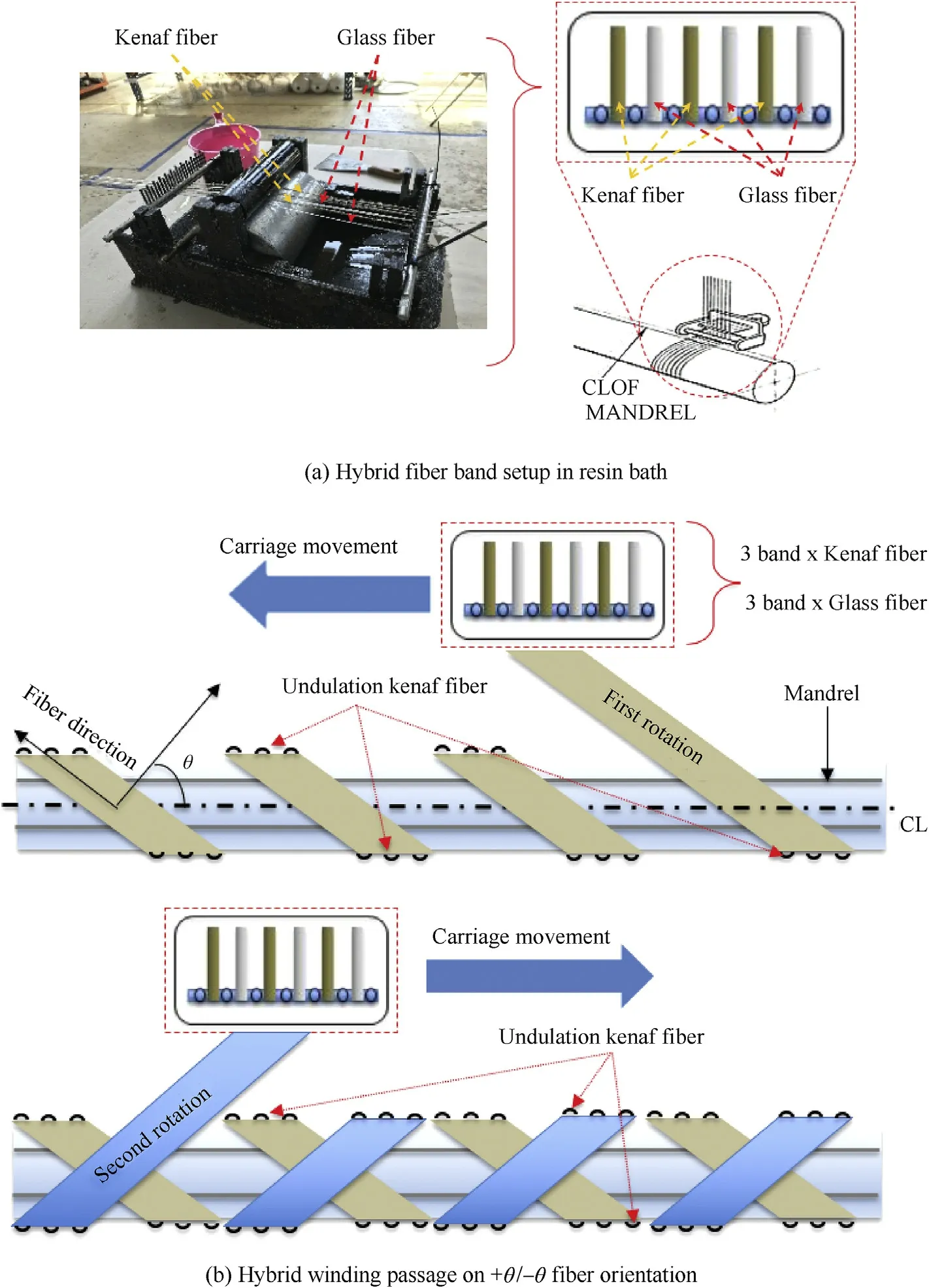
Fig.1. (a)The process of fiber band arrangement setup in resin bath and(b)The hybrid winding passage process and hybrid fiber arrangement with kenaf fiber undulation shape.
3.1. Axial quasi-static crushing failure modes
The previous experimental study by E. Mahdi et al. [33] has justified the complete failure modes of composite circular tubes E-glass woven fabric with epoxy resin is reflected by the fiber/matrix interface, fiber material, fiber content and matrix material. Meanwhile, Libo Yan and Nawawi Chouw [34] has describe four type of failure modes of flax fabric reinforced epoxy composite tubes which present the crushing deformation and crack propagation, whereas the type failure modes of the composite tube wall has reacted with various deformations of splaying, fragmentation and bending due to composite lamina bundle and elastic compression.Furthermore,the previous study [5,6,35-39] related to behavior of composite energy absorption tube have focused into failure modes categories through various failure modes characteristic which was categorized into mid-height collapse and unstable local buckling. Meanwhile,the failure modes in this study were recorded in Figs. 2-4, and shows that the collapse behavior of hybrid composite tube with the undulation wall has giving the resistance in transverse layer(inner layer) to decelerating the fracturing through longitudinal crack at wall,thus an initial failure of the of hybrid tube with three winding parameter was obviously occurred by a behavior of matrix fracturing and propagated along undulation fibers thread line at outer layer of tube wall.
3.1.1. Mode I - fiber/matrix cracking
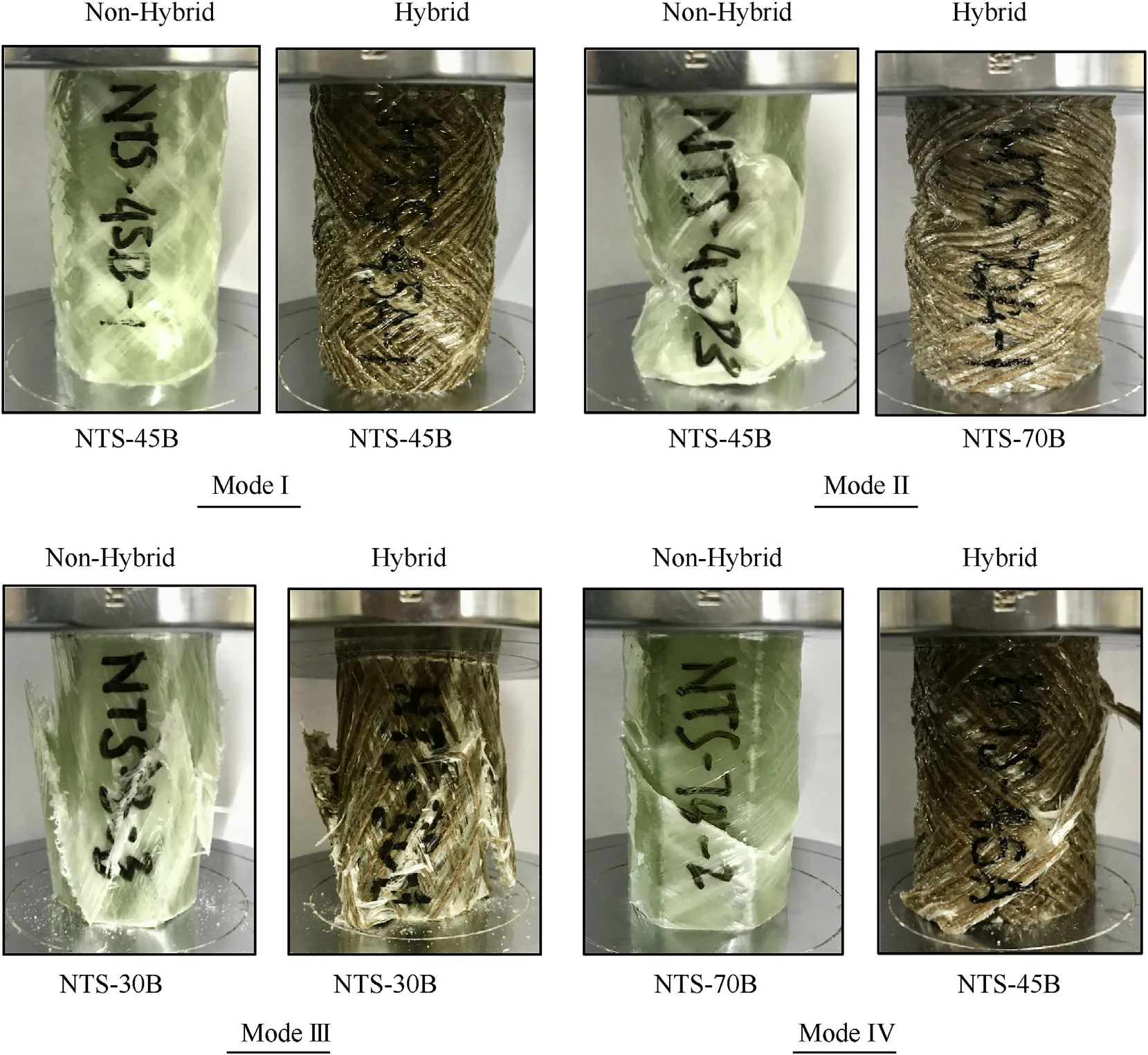
Fig. 2. Typical failure modes of hybrid and non-hybrid tube.
Mode I for hybrid specimen was characterized by the fiber/matrix fracturing at middle section-crushing with matrix crack has started at the outer layer of undulation fiber direction (fiberwinding orientation). For hybrid kenaf/glass composite material,the progressive crushing was started with matrix fracture along the undulation fiber was then growth formation of fracture along the fiber line and break the tube into two sections with large piece wedges.The wedges of breaking wall spread outwards while some of the fiber are tangling and slit off from the outer layer wall during the process of crushing.Although the non-hybrid (kenaf and glass fiber) composite tube, remained a characteristically matrixcontrolled crushing mode, the energy dissipated mechanisms were identified as interlaminar brittle fracturing collapse and the process of crushing, generate the formation of continuous fronds which spread outwards and inwards.Therefore,it was conditional that the absorbed energy or crushing mechanisms prevailing in crushing Mode I can be shown in the figures at Figs. 2-4.
3.1.2. Mode II - local buckling
Mode II was a mixture failure mode of local buckling mode, in which the crushing process was initiated by matrix crazing and cracking. In this mode, the failure of a specimen tube was dominated by non-hybrid(kenaf and glass fiber)composite tube but for the hybrid tube,it occurred at the specimen of the highest winding orientation tube.The early stage of crushing mode is characterized by the stable load-deformation behavior and was then beginning to crush in a local buckling at the mid-height of the tube.This type of failure mode was the best energy dissipated mechanism and was with excellent energy absorption capability through quasi-static axial crushing experiment for hybrid and non-hybrid composites tube due to the specimen condition was intact without any breaking into a piece of wedge or large debris at the final stage of crushing process.Therefore,the Mode II can be view with a physical conditional into energy dissipated mechanisms leading this crushing mode can be showed in the figures at Figs. 2-4.
3.1.3. Mode III - brittle fracturing
Mode III was interlaminar brittle fracturing collapse and crushing with internal and external tube wall break and splaying as a petal-like shape.This form of collapse mode occurred to the nonhybrid tube(kenaf fiber)and initially,the drop-off load observed at the end section of the specimen tube wall formed a concave shape and then the tube was buckling at the following deformation during the progressive crushing stage.During the progressive collapse,the tube wall splitting with frond broke off completely. Therefore,this failure mode was considered that the frictional resistance between the hybrid fiber and matrix, thus, this failure mode process formed the internal and external fronds which occurred splaying of lamina bundles and this shape provide a significant influence on energy dissipation mechanism. At the final crushing condition of this mode, the composite tube is tending to fragment into compaction and splaying into petal form. Mode III can find in the figures in Figs. 2-4.
3.1.4. Mode IV - delaminate

Fig.3. Comparison of the different stage of the collapse of hybrid kenaf/glass reinforced epoxy composite specimen tube (HTS-30A, HTS-45A, HTS-70A)and glass fiber reinforced epoxy composite specimen tube (NTS-30B, NTS-45B, NTS-70B) with different winding orientation tube effect.
Mode IV was a pattern of the transverse shearing crushing mode from Mode I and Mode II which was a mixture of failure mechanism mode showed by hybrid and non-hybrid composite tube specimens. The variable deformation pattern in Fig. 2 of the most hybrid specimen has shown a transverse crack occurs at the middle section-crushing together form a debris wedge due to transverse shearing and crushing of the fibers and matrix. The fragmented piece is associated with a crushing mechanism that involves extensive matrix deformation and fiber micro-fracture in small zones that moves progressively through the structure. The loaddeformation behavior of this type of failure is shown to be very stable along the post-crash stage for both hybrid and non-hybrid composite t. And the post-crash stage shows that the tube is breaking into a large piece of wedge or debris. And Mode IV, the mechanisms governing this crushing mode could be defined in the figures at Figs. 2-4.
3.2. Failure mechanism and collapse mode
The significant intralaminar crack grown was influenced by the circumference stiffness or hoop stress in the circumferential path process of the tube[2,26,38].From Fig.2 has shown the escalation of circumference stiffness could control crack foundational with θ increased,meanwhile the lamina bundle length has decreased with θ decreased.The increasing θ of certain orientation tended to cause a transition of various failure mode of the experiment specimens.According to Xiaolong Jia et al. [26] they reported with winding angle increasing from θ = 20°-80°, the compressive strength generally exhibited the decreasing trend where the crushing mode transformed from the fractured surface to four main mechanisms which are transverse shearing, lamina bending,local buckling and brittle fracturing.This behavior was also mentioned by Yifan Wang et al. [39] where the experimental results showed that all tubes deform in a similar brittle fracturing crushing mode.
In this present study,the quasi-static tests in Fig.3,HTS-30A and NTS-30B crushed in Mode I and III and HTS-45A crushed in Mode I.Fig.4 was a well-defined conversion of the final crushing condition of crushing Mode I to Mode III whilst θ increased from 30°to 45°.From Fig. 3, HTS-30A and NTS-30B, it could also be observed that the tubes were crushed in a similar crushing mode where the nonhybrid HTS-30A has to form a long frond length (wedges) meanwhile HTS-45 and HTS-70A was shorter due to the escalation of circumference stiffness and increasing of θ. Meanwhile from Fig. 3(a) also has shown both types of the tube has radically collapsed with a major splitting form,where the hybrid composite tube wall and glass composite tube depicted by the internal and external fronds with petal-profile in the progressive crushing process.
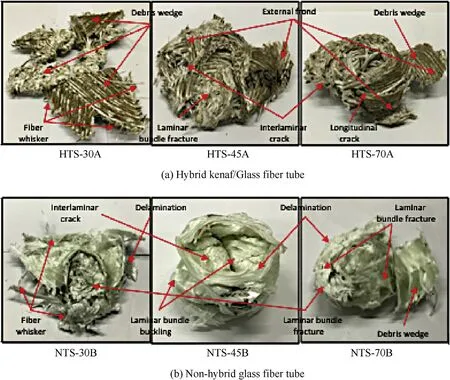
Fig. 4. Final crushing morphologies of specimens under axial quasi-static crushing load.
As θ increased from 30°to 70°,the crushing mode of hybrid tube changed from the various mode of failures, where the hybrid tube tendency to collapse in major wall splitting event. This was not stable with the development as showed by non-hybrid tube(glass fiber composite tube) tending to collapse intact without any large debris or wall split over. Overall, the failure mode for the hybrid tube are tending to delaminate, buckling, splitting, and splaying due to microfracture nucleated with small intralaminar and interlaminar crack. The hybrid composites with glass fibers showed good improvement in properties.
The interlaminar strength and the compression strength were found to be influenced by the hybridization of kenaf/glass fiber with the effect of winding orientation properties.From Figs.3 and 4 show that the progressive deformation under and final deformation of both composite tubes with various failure modes and the final shape deformation,and from Fig.4 it was noticed that hybrid composite tubes at θ=30°was intact with large fragments instead of small debris. This was due to the profile of fiber undulation at θ = 30°has cause the compression load was not uniformly distributed across the tube wall and causing failure at a lower stress.Unlike the other profile(θ=45°and 70°),the axial stress in the fiber is significantly increase but the interlaminar and transverse stresses decrease, causing tube wall failure into wedge and frond.
3.3. Load-displacement effect
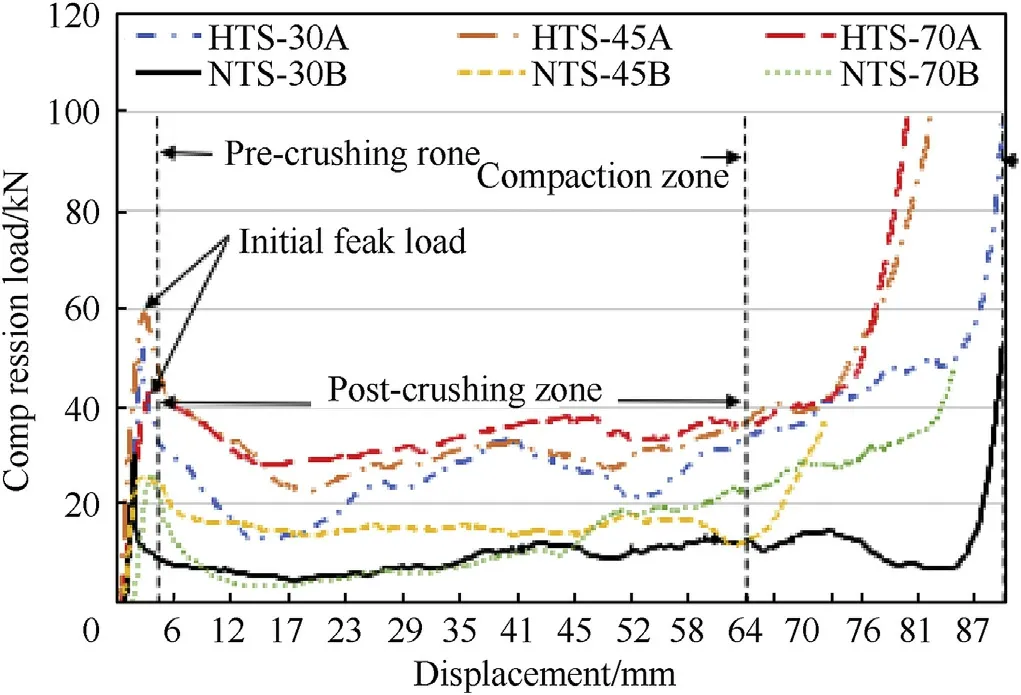
Fig. 5. Load-deformation characteristics of hybrid composite tube with various winding orientation fiber of hybrid fiber composition (kenaf & glass fiber reinforced epoxy) and non-hybrid composite tube (glass fiber reinforced epoxy).
Figs. 3 and 5 showed an evaluation of the progressive crushing load and composite tube displacement curves with increasing in winding orientation. The hybrid composite tube with the loaddeformation curves (Fig. 5) showed a comparable trend to synthetic composite tube. Therefore, it noticed that θ has an obvious effect on the crushing load and the hybrid composite tube shows an increasing trend of compression load effect compare to the synthetic composite tube.This result shows an increases peak load and the load curve fluctuates significantly along the displacement path.The load-displacement response of synthetic tube shows that this specimen is optimal, i.e. has outperformed all other specimens considered in this study, as displayed in Fig. 5
As increasing θ, the load energy in hybrid tube resulted the uptrend graph EA in Fig. 8. Moreover in Fig. 5, HTS-45A indicated the highest compression load and followed by HTS-30A. Though,the obvious of fluctuation of post-crushing zone for hybrid tube specimens are shown in Fig. 5, meanwhile the synthetic tube specimen curves were very stable in the post-crushing zone.Moreover, from the crush load-displacement curves of HTS-45A was indicated higher to other specimen of HTS-30A and HTS-70A,which predominantly describes HTS-45A by high axial stiffness value in compared with other synthetic composite tube.
Moreover,in Fig.4(a)and(b),the intralaminar and longitudinal cracks, has appear in the circumferential direction which created fronds during the collapse process of HTS-45A, HTS-70A and NTS-30B. In terms of HTS-45A, the higher crush load will initiate the fronds at the crushing process, and the circumferential cracks and fronds will easily spread through the undulation fiber area. The fractures and frond formation will propagate through the undulation tube wall, the lamina will certainly be peeled off and bundles fractured of tube wall will form at the final stage of the crushing process. From the above outcomes concludes that fiber loading or winding orientation(θ)parameters had an obvious influence on the collapse mode of the hybrid kenaf-glass composite tubes under quasi-static compression load condition.
3.4. Crashworthiness characteristic
3.4.1. Peak load (Pmax) and mean load (Pmean)
Fig. 6 displayed the outcome of θ on peak load (Pmax) of both hybrid and non-hybrid tube specimen under quasi-static compression load tests through the displacement of the specimen tubes. Where it obviously found that θ had a major influence on Pmax in both hybrid and non-hybrid tube specimen. From Fig. 6 showing the highest Pmaxat θ = 45°followed by θ = 30°and 70°for a hybrid specimen tube, meanwhile, for the non-hybrid tube,the increasing of θ give the decreased the value of Pmax. A comparison of Pmaxbetween hybrid and non-hybrid tubes quasi-static tests showed that the Pmaxhybrid tubes were approximately 1.7-2.4 times greater than the quasi-static of non-hybrid tubes due to the mechanical properties of hybrid fiber is improved from the non-hybrid tube.The result of final crushing displacement on Pmax was inconsistent while θ of hybrid and non-hybrid specimen tubes increased, while the maximum crushing displacement graph in hybrid and non-hybrid tube showed similarity for θ=30°45°and 70°specimen tubes. This phenomenon happened due to volume fraction%of matrix and fibers(Table 1)for each tube specimen are different.
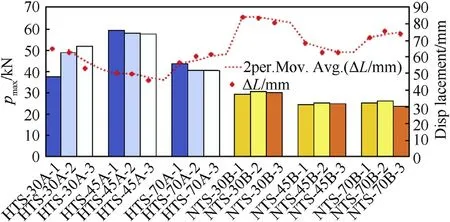
Fig.6. Comparative hybrid and non-hybrid composite tube graph of peak load(Pmax)on winding orientation effect and load displacement under quasi-static compression load condition.
Therefore,when the percentage(%)of matrix volume fraction is higher from fiber, it will cause the specimen more rigid from the other matrix volume percentage (%). Predominantly the rigidity of each composite structure will determine from the percentage of fiber/matrix volume. The curve in the load-deformation curve has indicated the peak load(Pmax)as commonly named as maximum force. Meanwhile for the mean load known as Pmean, which it is define the total absorbed energy per crushed tube length(ΔL),and the Pmeancalculated with, Eq. (1).

Pmax decreased with increasing θ from 45°to 70°under the quasi-static condition and then increased with increasing θ from 30°to 45°. Meanwhile, the Pmax of the synthetic composite tube showed that decreased in quasi-static condition with increasing θ from 30°to 70°. Therefore, the overall of the hybrid tube in Pmax results had a higher to the synthetic glass composite tube.
3.4.2. Crush load efficiency (CLE)
The CLE was a main characteristic to determine the stability of the crushing process and gauge performance of an EA for composite tube.Therefore,the near to unity value of CLE was an indicator for justified the characteristic of energy absorption tube study. Crush load efficiency(CLE)is a characteristic to evaluate the constancy of progressive crushing process,which CLE is described in percentage ratio of Pmean to Pmax, and the calculation with Eq. (2)

Fig. 7 mapped CLE for comparison of hybrid and a non-hybrid tube concerning θ in quasi-static compression load condition.Respectively, for both type of composite tube (hybrid and nonhybrid) specimens showed that the different value of CLE in regard of θ where the non-hybrid tube (glass fiber) was noted of θ=45°and 70°tube specimen are close the unity line compared to hybrid tube(kenaf/glass)which only θ=45°was close to unity line.Specimens for the hybrid tube with θ of 70°had the highest CLE,while specimens with θ of 30°for both tubes had the lowest CLE due to their load-displacement are remarkably high. This implied that specimens with θ of 45°of hybrid tube and θ of 45°and 70°of non-hybrid tube more likely tended to have a stable collapse failure behavior(see Fig.3(b)and(c)),meanwhile the other θ of 30°in both tube and θ of 70°in hybrid tube more likely tended to a catastrophic failure in Fig. 4(a).
The CLE of the specimen associated with the three winding orientation parameters with various load displacement,where the greater value of CLE showed that the failure of the specimen was closer to the progressive failure behavior. Thus, the CLE in Fig. 7 shown the winding parameter of θ = 70°for hybrid tube specimen has a better crashworthiness efficiency among other tube in winding orientation parameter, and load displacement for hybrid tube indicated lower than non-hybrid tube. Moreover, the characteristic of HTS-70A in Fig. 4(a) has address the desirable failure mode in crashworthy in hybrid structures in the form of combination failure mode final phase deformation. Meanwhile, from Fig. 7 for non-hybrid tubes are shown the fluctuation in load deformation spawned due to fiber volume fraction are high(Table 1), therefore the non-hybrid tubes are more stiffer than hybrid composite tube which cause the load displacement of nonhybrid tube is higher compare to the hybrid tube.
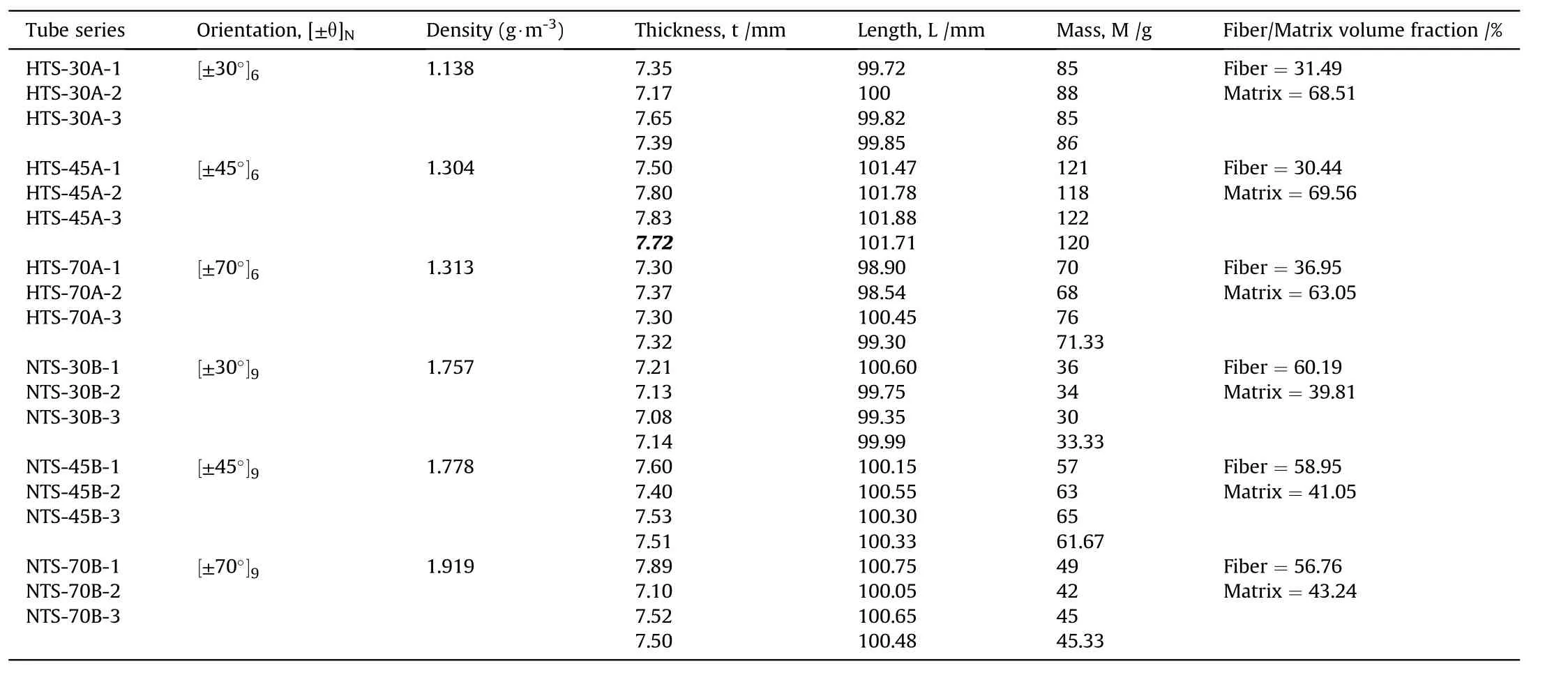
Table 1Nomenclature, geometry and dimensional details of the hybrid and non-hybrid tube specimens.
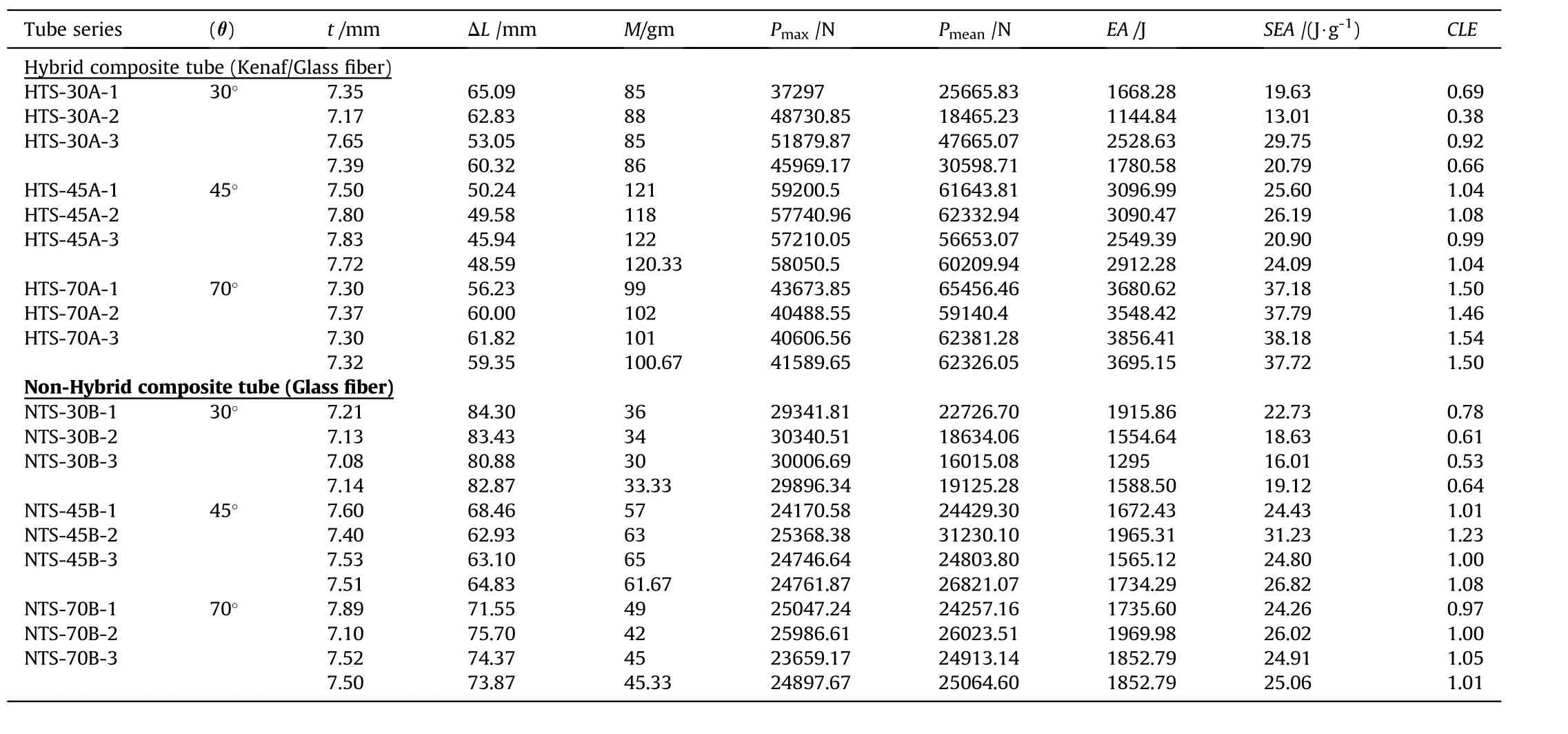
Table 2The results of hybrid and non-hybrid composite tube under quasi-static compression load.
3.4.3. Specific energy absorption (SEA)
Another important character to assess the crashworthiness in the composite structure was SEA. It was an indicator of energy absorption efficiency value of energy absorbed per unit mass of material.Specific energy absorption(SEA)is the main parameter to evaluate crashworthiness in structure.It was defined as the energy absorbed per unit of crushed specimen mass (M), and the SEA is calculated with Eq. (3)

Fig.8 displayed the influence of θ on the SEA of both hybrid and non-hybrid tube under quasi-static compression load condition.The SEA value showed the hybrid tube in a range from 10 J/g to 38 J/g and for non-hybrid tube in a range from 16 J/g to 31 J/g.As seen in Fig. 4, there were shows the final physical trend seen in both composite tubes under quasi-static compression load test results are similar in every θ effect.
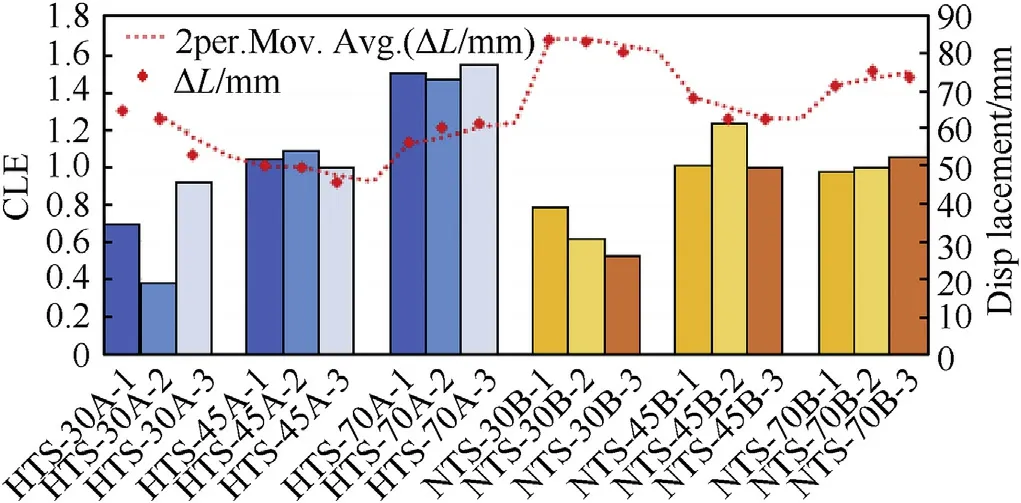
Fig. 7. Comparative hybrid and non-hybrid composite tube graph of CLE on winding orientation effect and load displacement under quasi-static compression load condition.
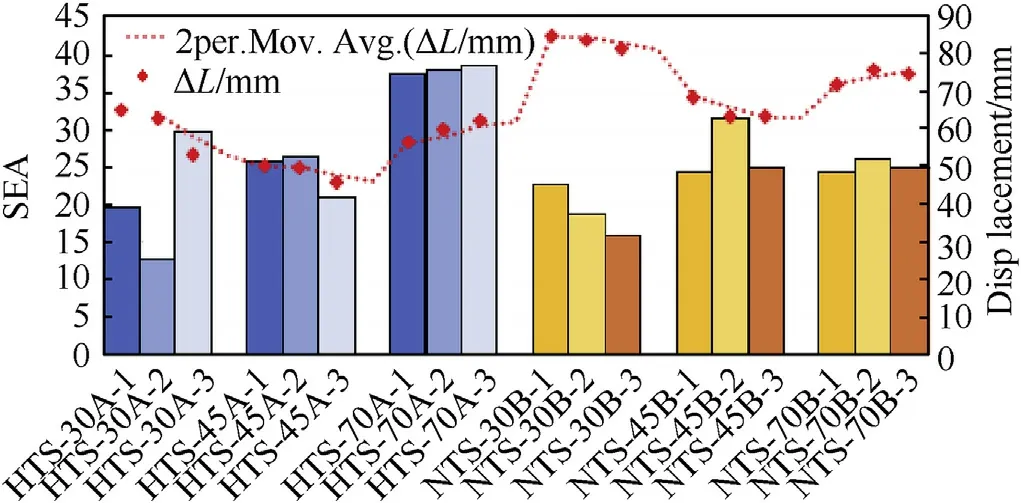
Fig. 8. Comparative hybrid and non-hybrid composite tube graph of SEA on winding orientation effect and load displacement under quasi-static compression load condition.
Therefore, in the term of hybrid tube comparison to the synthetic tube was showed that the hybrid tube can perform excellently under quasi-static same as the non-hybrid tube (glass composite tube).SEA of HTS-70A was 18-20%higher than the great glass fiber tube SEA(NTS-45B),meanwhile,the rest of hybrid tube HTS-30A and HTS-45A are a slightly similar reading of SEA,respectively.Overall results for SEA of hybrid composite tube shows that the increment of θ had relatively increased the SEA value,which the θ=70°winding orientation was the highest of the SEA,while a SEA of glass fiber composite tube have shown an increment of SEA value in the θ=30°-45°zone,and θ=45°-70°zone the SEA did not exhibit any significant trend when θ increases.
3.4.4. Energy absorption (EA)
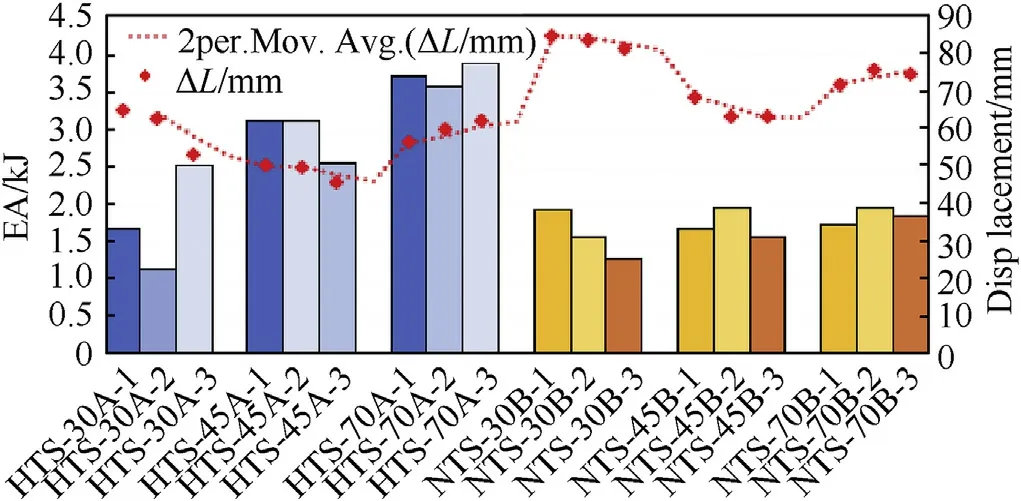
Fig. 9. Comparative Hybrid and non-Hybrid composite tube graph of winding orientation effect on EA and Load Displacement under Quasi-Static crush condition.
The EA result is shown in Fig. 9 of the stability in load compression is proportional with an increase of winding orientation(θ).Both hybrid and glass fiber composite tube specimen which at the θ=70°winding orientation are marked as the highest value in EA.The hybrid tube was showed the increment of EA value which affected by the increase of θ, meanwhile, for the glass fiber composite tube specimen, the effect of θ was not shown a major variation of the EA value. Therefore, the overall results of quasistatic compression load state led to a mutual energy absorption characteristic in another crashworthiness performance mechanism of Pmax, CLE, and SEA whereas a good EA of the hybrid composite tube was favourably desired to have the greater Pmax,CLE,and SEA.Therefore, the energy absorption (EA) is calculated with Eq. (4),where the integral of load-displacement with load (P) at each compression distance, and the area under load-displacement curve is equal to EA.

As shown in Fig.9,the effect of winding orientation has affected the EA of both specimens with various value of EA and load displacement.From Table 1,the fiber density at θ=70°has shown a high of fiber density among the winding parameter specimens which determine that the effect of winding orientation at θ = 70°for hybrid and non-hybrid tube have significantly increased the absorbed energy and strength as the fibers with higher densities are more stable and strong.
3.5. The effect of winding orientation on hybridization composite tube
This study has explored the influence of winding orientation on the energy absorption and crashworthiness performance. Indeed,the collapse behavior for hybrid kenaf/glass composite tube obviously influence by another factor present at the undulating surface,whereby,the presence of voids in undulation in hybrid tube at the outer surface has close linked with hybrid composite tube fabrication.Therefore,the Pmax of hybrid tube indicate at the θ of 30°is lower than θ of 45°due to fiber loading at 30°has contributed a long undulation fiber contour where the initial axial crack clearly develop/propagate along the undulation fiber line.
Otherwise,fibers density in Table 1,has showed that the density of hybrid kenaf/glass tube(1.138-1.313 g/m3)is lower compare to fiber density of glass fiber composite tube (1.757-1.919 g/m3),besides the overall results in mechanical properties of Pmax, SEA,CLE and EA of hybrid and non-hybrid is contradict, which the hybrid tube specimen has dominant in all results of mechanical properties. This phenomenon is happened due to natural fiber prominent as energy absorber properties [40,41], meanwhile the synthetic fiber material has great influence on strength and stiffness. M.R. Sanjay et al. [40] carried out research on natural fiberpolymer composite where investigations on the mechanical behavior of hybrid polymer-based composites reinforced with glass and natural fibers coir, jute and kenaf has resulted in enhance certain mechanical properties and impact strength. Thus, M.R.Sanjay et al. has concluded that the capability of natural fiber in hybrid tube has great ability compare single fiber in non-hybrid composite tube.
Therefore,in this study,both of composite tubes has discovered that the results in CLE,EA and SEA of winding parameter at θ of 30°were fluctuate in every specimen tested,it was due to axial profile of winding orientation of 30°is very wide which has lower the axial stress on inner and outer surface, therefore, the mechanical properties such SEA, EA and CLE are less compared to other winding orientation where θ = 45°and 70°are define as the hoop profile.The hoop profile in filament winding is defined when the winding tube is close to θ=90°.Besides,the study by Jingzhong Xing et al.[42] on the stress and deformation with multi-angle winding orientation of composite tube under axial loading has concur the above statement and results obtain, which indicated that the displacement and stresses calculation in hoop profile is higher compare to axial and radial stress profile. Thus, the effect of winding orientation in hybridization of natural/synthetic fiber in filament winding technique as hybrid energy absorbing tube could improve the conventional composite tube as a high-performance energy absorption tube application.
4. Conclusion
Filament winding Kenaf/Glass hybrid tube were fabricated.Quasi-static compression load test of hybrid kenaf/glass composite tube (HTS) and non-hybrid glass fiber composite tube were conducted to study the effect of hybridization and the fiber loading sequence (θ) sequence on the failure mode behavior and energy absorption capability.Based upon the results obtains the following remarks can be made:
a) The failure mode behavior of both composite tubes is strongly affected by the winding orientation arrangement.
b) The hybrid composite tube(HTS-70A)exhibited good energy absorption capability compared to other fiber loading parameters and all of the glass fiber composite tube (GFRP).
c) All of mechanical properties at winding orientation θ=30°of both composite tubes are fluctuated, which concluded that low winding profile at θ = 30°is not suitable for the axial compression load.
d) Kenaf fiber in hybrid kenaf/glass composite tube has significant ability in enhancing the energy absorption during the quasi-static compression load, even though hybrid composite tube has a lower fiber density than GFRP composite tube.
Acknowledgement
The authors would like to show appreciation to Universiti Putra Malaysia for financial support via the Graduate Research Fellowship(GRF)scholarship through the School of Graduate Study(UPM/SPS/GS47054) for providing a scholarship to the principal author to carry out this research project and HiCOE grant (6369107) from Ministry of Higher Education Malaysia.
杂志排行
Defence Technology的其它文章
- Analysis of the stress wave and rarefaction wave produced by hypervelocity impact of sphere onto thin plate
- Effect of bending temperatures on the microstructure and springback of a TRIP steel sheet
- Dynamic parameters of multi-cabin protective structure subjected to low-impact load - Numerical and experimental investigations
- An eikonal equation based path planning method using polygon decomposition and curve evolution
- Influence of active constrained layer damping on the coupled vibration response of functionally graded magneto-electro-elastic plates with skewed edges
- Consequence of reinforced SiC particles and post process artificial ageing on microstructure and mechanical properties of friction stir processed AA7075
